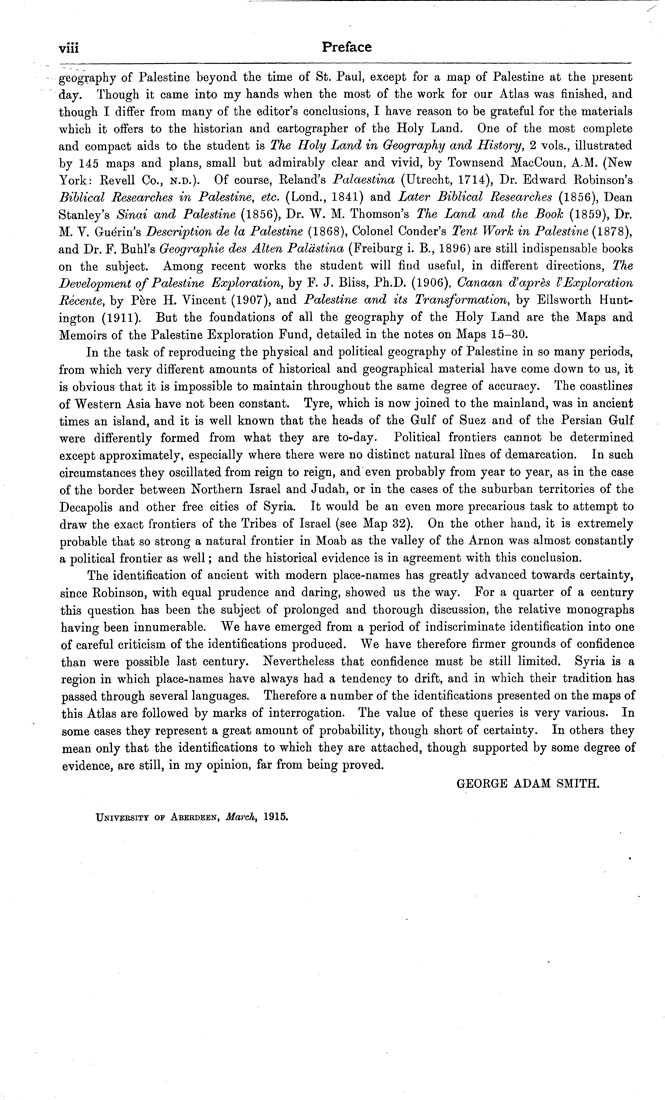viii Preface
geography of Palestine beyond the time of St. Paul, except for a map of Palestine at the present
day. Though it came into my hands when the most of the work for our Atlas was finished, and
though I differ from many of the editor's conclusions, I have reason to be grateful for the materials
which it offers to the historian and cartographer of the Holy Land. One of the most complete
and compact aids to the student is The Holy Land in Geography and History, 2 vols., illustrated
by 145 maps and plans, small but admirably clear and vivid, by Townsend MacCoun, A.M. (New
York: Revell Co., N.D.). Of course, Reland's Palaestina (Utrecht, 1714), Dr. Edward Robinson's
Biblical Researches in Palestine, etc. (Lond., 1841) and Later Biblical Researches (1856), Dean
Stanley's Sinai and Palestine (1856), Dr. W. M. Thomson's The Land and the Book (1859), Dr.
M. V. Guerin's Description de la Palestine (1868), Colonel Conder's Tent Work in Palestine (1878),
and Dr. F. Buhl's Geographic des Alten Paldstina (Freiburg i. B., 1896) are still indispensable books
on the subject. Among recent works the student will find useful, in different directions, The
Development of Palestine Exploration, by F. J. Bliss, Ph.D. (1906), Canaan d'apres VExploration
Recente, by P^re H. Vincent (1907), and Palestine and its Transformation, by Ellsworth Hunt¬
ington (1911). But the foundations of all the geography of the Holy Land are the Maps and
Memoirs of the Palestine Exploration Fund, detailed in the notes on Maps 15-30.
In the task of reproducing the physical and political geography of Palestine in so many periods,
from which very different amounts of historical and geographical material have come down to us, it
is obvious that it is impossible to maintain throughout the same degree of accuracy. The coastlines
of Western Asia have not been constant. Tyre, which is now joined to the mainland, was in ancient
times an island, and it is well known that the heads of the Gulf of Suez and of the Persian Gulf
were diff'erently formed from what they are to-day. Political frontiers cannot be determined
except approximately, especially where there were no distinct natural lines of demarcation. In such
circumstances they oscillated from reign to reign, and even probably from year to year, as in the case
of the border between Northern Israel and Judah, or in the cases of the suburban territories of the
Decapolis and other free cities of Syria. It would be an even more precarious task to attempt to
draw the exact frontiers of the Tribes of Israel (see Map 32). On the other hand, it is extremely
probable that so strong a natural frontier in Moab as the valley of the Arnon was almost constantly
a political frontier as well; and the historical evidence is in agreement with this conclusion.
The identification of ancient with modern place-names has greatly advanced towards certainty,
since Robinson, with equal prudence and daring, showed us the way. For a quarter of a century
this question has been the subject of prolonged and thorough discussion, the relative monographs
having been innumerable. We have emerged from a period of indiscriminate identification into one
of careful criticism of the identifications produced. We have therefore firmer grounds of confidence
than were possible last century. Nevertheless that confidence must be still limited. Syria is a
region in which place-names have always had a tendency to drift, and in which their tradition has
passed through several languages. Therefore a number of the identifications presented on the maps of
this Atlas are followed by marks of interrogation. The value of these queries is very various. In
some cases they represent a great amount of probability, though short of certainty. In others they
mean only that the identifications to which they are attached, though supported by some degree of
evidence, are still, in my opinion, far from being proved.
GEORGE ADAM SMITH.
Univeesity of Aberdeen, March, 1915,
|








